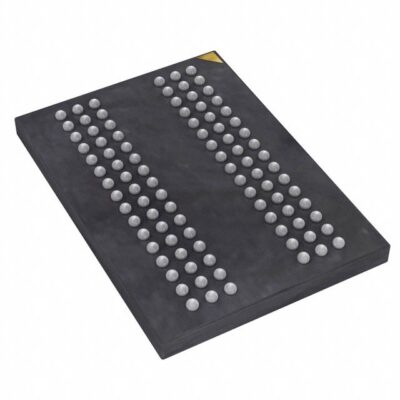MT41K256M16HA-125:E
Part Number: MT41K256M16HA-125:E
Manufacturer: Micron Technology, Inc.
Description: IC DRAM 4GBIT PARALLEL 96FBGA
Shipped from: Shenzhen/HK Warehouse
Stock Available: Check with us
ICRFQ.com - Electronic Components Distributor in China Since 2003

Part Number: MT41K256M16HA-125:E
Manufacturer: Micron Technology, Inc.
Description: IC DRAM 4GBIT PARALLEL 96FBGA
Shipped from: Shenzhen/HK Warehouse
Stock Available: Check with us
| Datasheet | |
|---|---|
| Category | Integrated Circuits (ICs) |
| Family | Memory |
| Manufacturer | Micron Technology Inc. |
| Series | – |
| Packaging | Tray |
| Part Status | Obsolete |
| Format – Memory | RAM |
| Memory Type | DDR3L SDRAM |
| Memory Size | 4G (256M x16) |
| Speed | 800MHz |
| Interface | Parallel |
| Voltage – Supply | 1.283 V ~ 1.45 V |
| Operating Temperature | 0°C ~ 95°C (TC) |
| Package / Case | 96-TFBGA |
| Supplier Device Package | 96-FBGA (9×14) |
The MT41K256M16HA-125:E is a type of DDR3 SDRAM that works at 1.35 volts and has a low voltage. It has a number of benefits over traditional DDR3 SDRAM, such as using less power and running faster. In this guide, we’ll look at the MT41K256M16HA-125:E DDR3L SDRAM’s most important features, specs, and how to use it.
DDR3L SDRAM is a type of DDR3 SDRAM (Double Data Rate 3 Synchronous Dynamic Random-Access Memory) memory card. It is made to work at a lower voltage than standard DDR3 SDRAM, which means it uses less power and uses it more efficiently.
DDR3L SDRAM modules are often used in laptops, PCs, servers, and embedded systems, among other types of computers. They can transfer data quickly and have a lot of memory, which makes them good for demanding apps that need to get to memory quickly and easily.
The working voltage is the main difference between DDR3L and DDR3. The normal voltage for DDR3 modules is 1.5 volts, while the voltage for DDR3L modules is 1.35 volts.By lowering the voltage, DDR3L uses less power and makes less heat, so it is more energy-efficient.
DDR3L modules are made to work with DDR3 slots, so when they are used with a DDR3 controller, they can run in 1.5V-suitable mode. This compatibility makes it easy to switch systems from DDR3 to DDR3L without having to change a lot of the hardware.
The use of DDR3L SDRAM has a number of benefits:
Overall, DDR3L SDRAM strikes a good balance between how well it uses power, how well it performs, and how much it costs. This makes it a popular memory option for a wide range of computer systems.
The 1.35V low-voltage mode is used by the MT41K256M16HA-125:E DDR3L SDRAM module. When compared to standard DDR3 SDRAM modules that run at 1.5V, this method uses less power and uses it more efficiently.
To make sure that everything works right in low-voltage mode, the memory controller and system must handle DDR3L SDRAM and be able to provide the voltage level that is needed. The power source and voltage regulator in the system should be set up so that the DDR3L SDRAM module always gets a stable 1.35V.
The MT41K256M16HA-125:E DDR3L SDRAM module was made to work with 1.5V DDR3 SDRAM as well. This means that when it is used with a DDR3 processor, it can work in 1.5-volt compatible mode.
When the module is in 1.5V compatible mode, it acts like regular DDR3 SDRAM and needs a 1.5V supply power. This makes it easy to switch from DDR3 to DDR3L without having to change a lot of gear.
It’s important to remember that if you use the MT41K256M16HA-125:E module in 1.5V compatible mode, you might not get the benefits of low voltage operation, like less power use. So, to take advantage of the benefits of DDR3L SDRAM, it is best to run the module at its low voltage setting of 1.35 volts.
For best performance and compatibility, the MT41K256M16HA-125:E DDR3L SDRAM module should be set up with the right voltage and timing settings. This means setting the supply voltage and setting up the different timing factors.
The voltage and timing values may be different depending on what the system needs and what DDR3L controller is being used. For the suggested voltage and timing specifications, it is important to look at the manufacturer’s datasheet or technical documentation.
Most of the time, you can change the voltage and timing settings in the machine’s BIOS or UEFI settings. For the DDR3L SDRAM module to work well and reliably, these settings should be carefully set up according to the manufacturer’s instructions.
The MT41K256M16HA-125:E DDR3L SDRAM module’s best performance and stability depend on how well it handles heat. For proper heat dissipation and to avoid overheating, it is important to understand the thermal specifications given by the maker.
To avoid thermal throttling, a drop in performance, or an early failure of the DDR3L SDRAM module, it is important to understand and follow these thermal standards.
Heat Spreader and Ways to Keep Cool
More cooling options can be used to improve the way the DDR3L SDRAM module deals with heat. These methods help get rid of heat more efficiently, keeping temperatures low and making the module more reliable overall. Some common ways to cool down are:
It is best to follow the guidelines and recommendations given by the module manufacturer when choosing and installing cooling solutions. This is because the module manufacturer can give specific directions and advice on the best ways to handle heat in relation to the MT41K256M16HA-125:E DDR3L SDRAM module.
In conclusion, the MT41K256M16HA-125:E DDR3L SDRAM is a high-performance memory module that works well with low voltage. By following the rules and standards in this guide, system designers can easily add DDR3L SDRAM to their applications and get the best performance out of it. Contact ICRFQ right away to find out how to use the MT41K256M16HA-125:E’s amazing powers to their fullest.
WhatsApp us